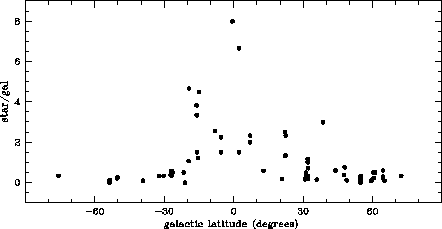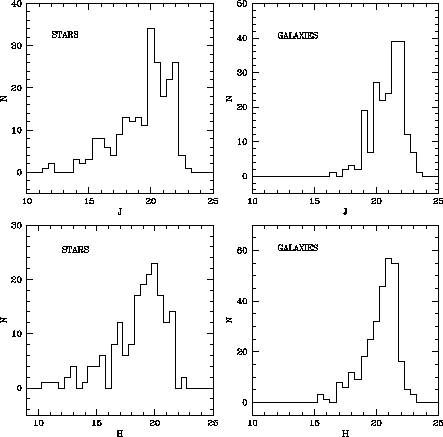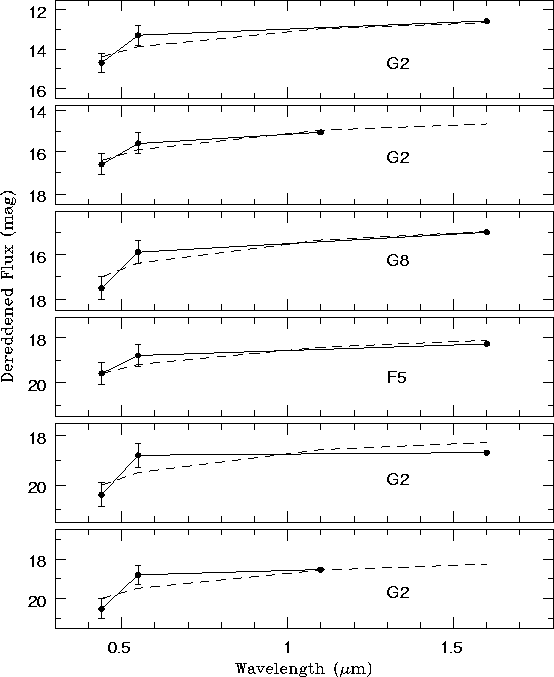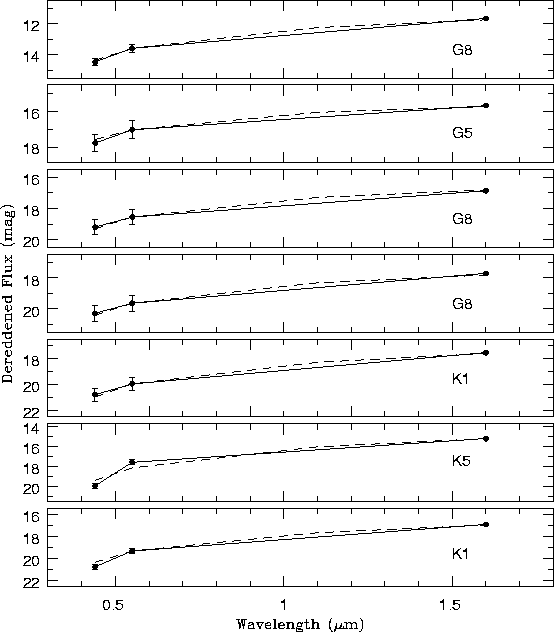



Next: The Evolution of Stars
Up: NICMOS Science
Previous: A Coronagraphic Search for
Subsections
A. Pasquali, G. De Marchi and W. Freudling
ST European Coordination Facility - ESO,
Karl-Schwarzschild-Strasse 2, Garching bei München,
Germany, D-85748, E-mail: apasqual@eso.org
Abstract:
We present the preliminary results of the analysis of the NICMOS/GRISM
parallel observations from programs

7811, 7922 and 7907.
Images and spectra have been reduced and calibrated through
CALNICC and NICMOSLOOK. We have used the morphology and the radial profile of
the objects identified by CALNICC on the direct images together with
the SExtractor class parameter defined by CALNICC for each object to
separate stars from galaxies. We here discuss the stars/galaxies
distributions in the J and H bands and their corresponding
color-magnitude diagrams obtained from both imaging and spectroscopic
data.
stellar population,late spectral types
NICMOS Camera 3 is being used in parallel mode to observe galactic
fields at both high and low galactic latitudes. One of the scientific
goals of the NICMOS campaign is to detect substellar objects, such as
brown dwarfs and objects close to the stellar mass-cutoff. The
astrophysical relevance of these stellar categories covers many issues,
from the star formation mechanisms to the physics of stellar
atmospheres, the nature of the dark matter and the galactic structure.
Parallel observations are mostly made in the J and H bands. For
each telescope pointing, they comprise
direct imaging through the F110W and the F160W filters and grism
spectroscopy with the G096 and G141 grisms. Acquisitions are typically
of about 250 s and 900 s for imaging and spectroscopy, respectively. The
corresponding program IDs are 7811, 7907 and 7922.
The data are processed using the NICMOS pipeline; dithered exposures of
the same fields are associated and combined into one image, which is
then the input for CALNICB. The direct and grism combined images are
used for each pointing by CALNICC in order to identify the objects in
the field, derive their J, H photometry from the direct image and
extract and calibrate their low dispersion spectra from the grism
acquisition.
We have reduced and analysed so far the NIC3 data obtained for 52
independent field pointings. Out of these, only 13 fields have been
observed through both F110W and F160W filters and G096 and G141 grisms;
22 have been imaged only in F160W and the corresponding G141, and only
17 have been acquired through F110W and G096. Most of the fields are at
high galactic latitude; as Figure 1 shows, only 8 pointings are within
|b| = 10o, i.e. the galactic disk.
Figure 1:
NICMOS parallel fields distribution in galactic latitude.
 |
We have run CALNICC over the data in order to identify the objects in
each frame, measure their fluxes and CLASS parameter through SExtractor,
which has been implemented in CALNICC for object identification and
photometry. The CLASS parameter may be considered as a sort of
ellipticity indicator, so that those objects having CLASS  0.85 may be
classified as point sources. Since the CLASS parameter seems to be
sensitive to variable sky background, we have also traced the radial
profile for each identified object and given more weight to the latter
to distinguish stars from galaxies. Figure 2
shows the distribution of the objects classified either as stars or
galaxies from their radial profiles as a function of their CLASS
parameter. It is clear that there is an excellent agreement between
the CLASS- and radial-profile- classifications in the case of galaxies,
while there may be
0.85 may be
classified as point sources. Since the CLASS parameter seems to be
sensitive to variable sky background, we have also traced the radial
profile for each identified object and given more weight to the latter
to distinguish stars from galaxies. Figure 2
shows the distribution of the objects classified either as stars or
galaxies from their radial profiles as a function of their CLASS
parameter. It is clear that there is an excellent agreement between
the CLASS- and radial-profile- classifications in the case of galaxies,
while there may be  30
30 contamination for the stars sample.
contamination for the stars sample.
Figure 2:
Histograms of stars and galaxies classified by their radial
profile as a function of their CLASS parameter. The solid and the dotted
lines represent objects detected in the F110W and F160W images,
respectively.
 |
We have classified a total of 418 stars and 546 galaxies down to the
magnitude set by a detection limit of 5 above the local
background. It is then interesting to correlate the number of stars
and galaxies with the galactic latitude of the analysed field pointings.
The ratio of stars to galaxies has been plotted in Figure 3 as a
function of galactic latitude: a clear increase in the number of
detected stars over galaxies is seen towards the galactic bulge and
disk.
above the local
background. It is then interesting to correlate the number of stars
and galaxies with the galactic latitude of the analysed field pointings.
The ratio of stars to galaxies has been plotted in Figure 3 as a
function of galactic latitude: a clear increase in the number of
detected stars over galaxies is seen towards the galactic bulge and
disk.
Figure 3:
The number ratio of stars to galaxies for the individual 52
pointings as a function of galactic latitude.
 |
The aperture fluxes measured by SExtractor in CALNICC have been
transformed into the HST instrumental magnitudes for both stars
and galaxies by reading the inverse sensitivity PHOTLAM from the images
header and adopting a zero-point of 21.1 mag. Subsequently, the
instrumental F110W and F160 W magnitudes have been translated into the
Vegamag system magnitudes by subtracting 2.3 mag and 3.7 mag,
respectively. These magnitudes are more similar, although not identical,
to J and H in the Johnson - Cousin system.
Since 4 fields were observed several times through both filters,
we have been able to estimate from them our photometric uncertainty,
which turns out to be  0.1 mag in both bands for magnitudes
brighter than 19, while it increases up to 0.5 down to the limiting
magnitude. Figure 4 describes the photometric properties of our
samples: stars are characterized by a limiting magnitude of 23 in J and
22.5 in H. Their distribution peaks at about 20 in J and H with a bright
tail extending up to 11.5 in J and 11 in H. The limiting magnitude for
galaxies is somewhat fainter: 23.5 in J and 23 in H. Galaxies peak at
about 22 in J and 21 in H and can be as bright as 16 mag in J and 15 mag
in H. These limiting magnitudes are of course set by the relatively
short exposure times and also by the fact that, at fainter magnitudes,
galaxies are more easily detected than stars due to their extended structure.
0.1 mag in both bands for magnitudes
brighter than 19, while it increases up to 0.5 down to the limiting
magnitude. Figure 4 describes the photometric properties of our
samples: stars are characterized by a limiting magnitude of 23 in J and
22.5 in H. Their distribution peaks at about 20 in J and H with a bright
tail extending up to 11.5 in J and 11 in H. The limiting magnitude for
galaxies is somewhat fainter: 23.5 in J and 23 in H. Galaxies peak at
about 22 in J and 21 in H and can be as bright as 16 mag in J and 15 mag
in H. These limiting magnitudes are of course set by the relatively
short exposure times and also by the fact that, at fainter magnitudes,
galaxies are more easily detected than stars due to their extended structure.
Figure 4:
The magnitude distributions of stars and galaxies in the J and
H bands.
 |
We have here restricted our analysis to the stellar sample. We have used
the 13 field pointings observed in both F110W and F160W filters to
construct the color-magnitude diagram in Figure 5, where the magnitudes
are not dereddened.
Figure 5:
The observed color-magnitude diagram of the stars detected in
13 fields imaged through both F110W and F160W filters.
 |
The distribution peaks around (J-H) = 1, typical of late spectral types;
it is however broadened between 0.5 and 1.5 because of the photometric
uncertainty, which becomes quite large ( 0.5 mag) for those stars close
to the limiting magnitude. It is known that the (J-H) color is not
particularly sensitive in discriminating stars of different late
spectral type and metallicity; to do this, at least a second color is
required. To better understand the spectral type of the objects in
Figure 5, we have defined the color (I-J)' as (I' - J'), where I' is the
magnitude in a box filter between 0.8
0.5 mag) for those stars close
to the limiting magnitude. It is known that the (J-H) color is not
particularly sensitive in discriminating stars of different late
spectral type and metallicity; to do this, at least a second color is
required. To better understand the spectral type of the objects in
Figure 5, we have defined the color (I-J)' as (I' - J'), where I' is the
magnitude in a box filter between 0.8  m and 0.9
m and 0.9  m and J' covers
the range 1.05
m and J' covers
the range 1.05  m to 1.15
m to 1.15  m. We have measured the (I-J)' color
using the G096 grism spectra for all stars in the 13 fields brighter
than J = 20 which ensures a good spectral S/N ratio. We have also
computed the (I-J)' color for stars of late spectral type in the BPGS
library available in IRAF in order to build a comparison grid of
known spectral types. The resulting two colors diagram is shown in Figure 6,
where the (I-J)' and (J-H) colors of the detected stars are not
corrected for reddening.
m. We have measured the (I-J)' color
using the G096 grism spectra for all stars in the 13 fields brighter
than J = 20 which ensures a good spectral S/N ratio. We have also
computed the (I-J)' color for stars of late spectral type in the BPGS
library available in IRAF in order to build a comparison grid of
known spectral types. The resulting two colors diagram is shown in Figure 6,
where the (I-J)' and (J-H) colors of the detected stars are not
corrected for reddening.
Figure 6:
The observed two colors diagram of the stars detected in
13 fields imaged through both F110W and F160W filters (black dots).
Also plotted are the colors derived from the BPGS library spectra (open
squares).
 |
The comparison shows that the detected stars are mostly dwarfs of K and
M spectral types.
We have also adopted an alternative approach to the problem of deriving
stellar spectral types. In fact, we have been able to cross-identify 13
stars out of 418 with the US Navy Observatory Catalogue which has
provided us with photographic B and V magnitudes, subsequently scaled to
the Johnson system. The typical B and V photometric error is of 0.25 mag and
0.5 mag for stars at positive and negative galactic latitude,
respectively, and the cross-identification is uncertain by about 1
arcsec. For the 13 cross-identified stars we have estimated the
reddening from the HI maps of Stark et al. (1992), which give
the HI column density for each position in the sky. HI column densities have
been transformed into E(B-V) through the relation of Diplas & Savage
(1994): N(HI) = 4.93  1021E(B-V), and we have used the
E(B-V) values derived in this way to correct for reddening the available B, V,
J and H magnitudes. We have been able at this point to trace the Spectral
Energy Distribution (SED) for the 13 stars and match each of these to
the SEDs derived from the BPGS spectra. The best fits are shown in
Figures 7 and 8, where the errorbars are those of the USN Observatory
Catalogue for the B and V bands, and are set to 0.1 mag for the NICMOS J
and H bands being brighter than 19 mag (cfr. Sect. 2).
Although fits generally get worse at B and V magnitudes fainter
than 18, we may conclude that they add a noticeable component of G
dwarfs to the previous population of K and M dwarfs (cfr. Figure 6).
1021E(B-V), and we have used the
E(B-V) values derived in this way to correct for reddening the available B, V,
J and H magnitudes. We have been able at this point to trace the Spectral
Energy Distribution (SED) for the 13 stars and match each of these to
the SEDs derived from the BPGS spectra. The best fits are shown in
Figures 7 and 8, where the errorbars are those of the USN Observatory
Catalogue for the B and V bands, and are set to 0.1 mag for the NICMOS J
and H bands being brighter than 19 mag (cfr. Sect. 2).
Although fits generally get worse at B and V magnitudes fainter
than 18, we may conclude that they add a noticeable component of G
dwarfs to the previous population of K and M dwarfs (cfr. Figure 6).
We will extend the present analysis to the remaining data of the NIC3
Parallel Campaign and follow up this study by addressing two main
astrophysical issues: the spatial distribution,
the Luminosity Function (LF) and hence the Initial
Mass Function (IMF)of galactic low mass stars.
Figure 7:
Fits to the observed, dereddened SEDs.
 |
Figure 8:
Fits to the observed, dereddened SEDs.
 |
We would like to thank Norbert Pirzkal for supporting the data reduction
software during this work. We would also like to thank Luca Pasquini for
useful discussions.





Next: The Evolution of Stars
Up: NICMOS Science
Previous: A Coronagraphic Search for
Norbert Pirzkal
1998-07-09




![]() 1021E(B-V), and we have used the
E(B-V) values derived in this way to correct for reddening the available B, V,
J and H magnitudes. We have been able at this point to trace the Spectral
Energy Distribution (SED) for the 13 stars and match each of these to
the SEDs derived from the BPGS spectra. The best fits are shown in
Figures 7 and 8, where the errorbars are those of the USN Observatory
Catalogue for the B and V bands, and are set to 0.1 mag for the NICMOS J
and H bands being brighter than 19 mag (cfr. Sect. 2).
Although fits generally get worse at B and V magnitudes fainter
than 18, we may conclude that they add a noticeable component of G
dwarfs to the previous population of K and M dwarfs (cfr. Figure 6).
1021E(B-V), and we have used the
E(B-V) values derived in this way to correct for reddening the available B, V,
J and H magnitudes. We have been able at this point to trace the Spectral
Energy Distribution (SED) for the 13 stars and match each of these to
the SEDs derived from the BPGS spectra. The best fits are shown in
Figures 7 and 8, where the errorbars are those of the USN Observatory
Catalogue for the B and V bands, and are set to 0.1 mag for the NICMOS J
and H bands being brighter than 19 mag (cfr. Sect. 2).
Although fits generally get worse at B and V magnitudes fainter
than 18, we may conclude that they add a noticeable component of G
dwarfs to the previous population of K and M dwarfs (cfr. Figure 6).
